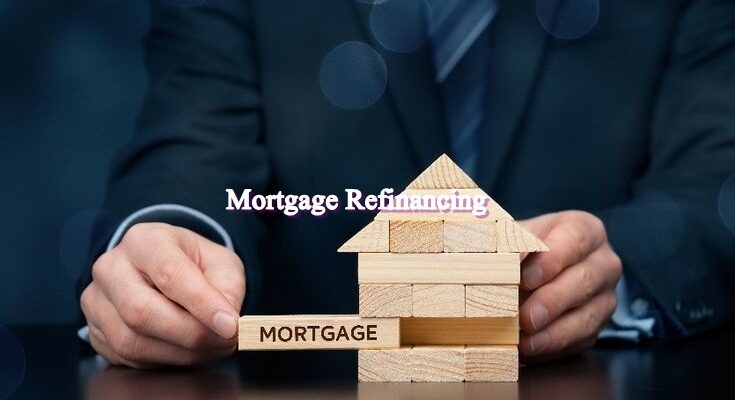Mortgage refinancing is a financial process in which a homeowner takes out a new loan to pay off an existing mortgage. The new loan often comes with different terms, such as a lower interest rate, a different loan term (the period over which the loan is repaid), or a switch from an adjustable-rate mortgage (ARM) to a fixed-rate mortgage (FRM) or vice versa. The primary goal of refinancing is often to reduce monthly mortgage payments, shorten the loan term, or tap into the home’s equity, Mortgage Refinancing How to Lower Your Payments and Save Money.
Mortgage Refinancing: How to Lower Your Payments and Save Money ,For many homeowners, refinancing can be a powerful financial tool, but it’s not without risks. Understanding the ins and outs of mortgage refinancing is crucial, especially if you’re new to the concept or considering it for the first time.
Why Do Homeowners Refinance Their Mortgages
Lower Interest Rates: One of the most common reasons for refinancing is to take advantage of lower interest rates. If interest rates have dropped since you originally took out your mortgage, refinancing could reduce your monthly payments and the total interest paid over the life of the loan .Reduce Monthly Payments: By securing a lower interest rate or extending the term of your loan, you can reduce your monthly mortgage payments. This can free up cash for other expenses or savings. Shorten the Loan Term: Some homeowners choose to refinance into a shorter-term loan, such as moving from a 30-year mortgage to a 15-year mortgage. While this usually increases the monthly payment, it can significantly reduce the amount of interest paid over the life of the loan and help you pay off your mortgage faster .Switch from an Adjustable-Rate to a Fixed-Rate Mortgage (or Vice Versa): Homeowners with an adjustable-rate mortgage (ARM) may refinance to a fixed-rate mortgage (FRM) for more predictable monthly payments, especially if interest rates are expected to rise. Conversely, some may switch from an FRM to an ARM if they anticipate moving soon and want to take advantage of lower initial rates .Access Home Equity (Cash-Out Refinancing): Cash-out refinancing allows homeowners to borrow against their home’s equity (the difference between the home’s current value and the remaining mortgage balance). The new mortgage is larger than the old one, and the difference is paid to the homeowner in cash. This can be used for home improvements, paying off high-interest debt, or other financial needs. Consolidate Debt: Some homeowners use cash-out refinancing to consolidate higher-interest debts, such as credit card balances or personal loans, into a single, lower-interest mortgage payment. This can simplify finances and potentially reduce overall interest costs.
Types of Mortgage Refinancing
There are different types of mortgage refinancing options available, each suited to different financial situations and goals. The most common types include:
Rate-and-Term Refinance
Definition: A rate-and-term refinance is the most straightforward type of refinancing, where the primary goal is to change the interest rate, the term of the loan, or both, without increasing the loan amount .When to Consider: This option is ideal if you want to lower your monthly payments, pay off your mortgage sooner, or stabilize your payments with a fixed-rate mortgage.
Cash-Out Refinance:
Definition: In a cash-out refinance, you take out a new mortgage for more than you owe on your current mortgage and receive the difference in cash. This type of refinance taps into your home equity .When to Consider: Use this option if you need a large sum of cash for significant expenses like home renovations, education costs, or debt consolidation.
Cash-In Refinance:
Definition: A cash-in refinance involves paying down a significant portion of your mortgage principal when you refinance, reducing the new loan amount. When to Consider: This is beneficial if you want to lower your loan-to-value ratio (LTV), eliminate private mortgage insurance (PMI), or achieve a better interest rate.
No-Closing-Cost Refinance:
Definition: A no-closing-cost refinance rolls the closing costs into the loan principal or exchanges them for a slightly higher interest rate. When to Consider: This option is suitable if you want to avoid paying upfront costs but are willing to pay slightly more over time through a higher interest rate or larger loan balance.
The Refinancing Process
Refinancing a mortgage follows a series of steps similar to obtaining the original mortgage. Here’s a breakdown of the typical process:
Assess Your Financial Situation:
Credit Score: Your credit score plays a crucial role in the refinancing process. A higher score can help you secure better interest rates .Income and Employment: Lenders will review your income and employment history to ensure you can afford the new loan payments. Debt-to-Income Ratio (DTI): Your DTI ratio, which compares your monthly debt payments to your gross monthly income, will also be evaluated. A lower DTI ratio is generally favorable.
Determine Your Refinancing Goals:
Lowering Interest Rate: Calculate the potential savings from a reduced interest rate. Changing Loan Term: Decide if you want to shorten or extend your loan term. Tapping Equity: Determine how much cash you want to take out, if any .Switching Loan Types: Consider whether changing from an ARM to an FRM, or vice versa, would benefit you.
Shop Around for Lenders:
Compare Offers: It’s essential to compare loan offers from multiple lenders to find the best terms and rates. Pay attention to the Annual Percentage Rate (APR), which reflects the true cost of the loan, including fees .Understand Fees: Be aware of the fees associated with refinancing, such as appraisal fees, origination fees, and closing costs. These can add up, so factor them into your decision-making.
Apply for the New Loan:
Provide Documentation: You’ll need to submit various documents, including proof of income, tax returns, bank statements, and information about your current mortgage .Loan Estimate: After you apply, the lender will provide a Loan Estimate, detailing the estimated interest rate, monthly payment, and closing costs for the new loan.
Underwriting:
Credit Check: The lender will check your credit history and score. Appraisal: An appraisal of your home’s value will be conducted to ensure it supports the new loan amount .Income and Assets Verification: The lender will verify your income and assets to confirm you can afford the new loan payments.
Closing:
Review Documents: At closing, you’ll sign the final loan documents. Carefully review everything to ensure the terms match what you agreed to. Pay Closing Costs: You’ll need to pay any remaining closing costs at this time unless you’ve opted for a no-closing-cost refinance. Funding: Once the closing is complete, your new mortgage will pay off the old one, and if it’s a cash-out refinance, you’ll receive the cash you’re borrowing.
Benefits of Mortgage Refinancing
Mortgage refinancing offers several potential benefits, but the specific advantages depend on your financial situation and goals. Here are some key benefits:
Lower Monthly Payments: A reduced interest rate can lower your monthly mortgage payment, freeing up cash for other uses. This is particularly beneficial if you’re looking to increase your monthly savings or need to reduce financial strain.
Shorten Loan Term: Refinancing to a shorter loan term, like moving from a 30-year mortgage to a 15-year mortgage, allows you to pay off your mortgage faster and reduce the total interest paid over the life of the loan. Although your monthly payments may increase, the long-term savings can be substantial.
Switch to a More Stable Loan: If you currently have an adjustable-rate mortgage (ARM) and are concerned about rising interest rates, refinancing to a fixed-rate mortgage (FRM) can provide stability with predictable monthly payments. This can be particularly valuable if you plan to stay in your home for the long term.
Access Home Equity: With a cash-out refinance, you can tap into the equity you’ve built in your home, providing you with a lump sum of cash that can be used for various purposes, such as home improvements, paying off high-interest debt, or funding significant expenses like education or medical bills.
Eliminate Private Mortgage Insurance (PMI): If your home’s value has increased since you purchased it, refinancing could help you eliminate PMI, which is often required if your original down payment was less than 20% of the home’s value. This can save you a significant amount of money each month.
Consolidate Debt: Refinancing can be an effective way to consolidate high-interest debts into a single, lower-interest mortgage payment. This not only simplifies your financial life but can also reduce the amount of interest you pay over time, potentially saving you a substantial amount of money.
Improve Your Financial Flexibility: By lowering your monthly payments or accessing cash through a cash-out refinance, you can improve your overall financial flexibility. This can be particularly helpful in managing your budget, saving for future needs, or handling unexpected expenses.
Risks and Drawbacks of Mortgage Refinancing
While refinancing can offer numerous benefits, it’s not without risks and potential downsides. Here are some of the key risks to consider:
Closing Costs: Refinancing a mortgage involves closing costs, which can range from 2% to 5% of the loan amount. These costs can add up, potentially offsetting the savings from a lower interest rate, especially if you plan to sell your home in the near future.
Longer Break-Even Period: The break-even period is the time it takes for the savings from the new loan to cover the closing costs. If you don’t plan to stay in your home long enough to reach the break-even point, refinancing may not be financially beneficial.
Higher Total Interest Paid: If you extend your loan term by refinancing, even at a lower interest rate, you might end up paying more in total interest over the life of the loan. This is because the interest is spread out over a longer period.
Risk of Foreclosure: Taking out a larger loan, particularly in a cash-out refinance, increases the amount you owe on your home. If your financial situation changes and you’re unable to make the higher payments, you could be at risk of foreclosure.
Private Mortgage Insurance (PMI): If your home’s value has decreased or you’ve taken out a larger loan, you might be required to pay PMI, which can add to your monthly costs.
Impact on Credit Score: Refinancing involves a hard credit inquiry, which can temporarily lower your credit score. Additionally, if you take on more debt through a cash-out refinance, it could affect your credit utilization ratio and further impact your score.
Complex Process: The refinancing process can be complex and time-consuming, requiring significant paperwork, an appraisal, and thorough financial review. If you’re not prepared or if your financial situation has changed since you took out your original mortgage, it could be more challenging to qualify for a refinance.
When Is It Worth Refinancing?
Deciding whether to refinance your mortgage depends on several factors, including your financial goals, the costs of refinancing, and how long you plan to stay in your home. Here are some scenarios where refinancing might make sense:
Interest Rates Have Dropped Significantly: If current mortgage rates are substantially lower than when you first took out your loan, refinancing could save you a considerable amount of money on interest over the life of the loan.
You Want to Shorten Your Loan Term: Refinancing to a shorter loan term can help you pay off your mortgage faster and reduce the total interest paid. This is a good option if you can afford higher monthly payments and want to become mortgage-free sooner.
You Need to Tap Into Your Home Equity: If you have significant equity in your home and need cash for large expenses, a cash-out refinance can provide the funds you need, often at a lower interest rate than other types of loans.
You Want to Switch Loan Types: If you have an ARM and are concerned about rising interest rates, refinancing to a fixed-rate mortgage can provide stability with predictable monthly payments. Alternatively, if you plan to sell your home soon, switching from a fixed-rate to an ARM with a lower initial rate could save you money in the short term.
You Want to Eliminate PMI: If your home’s value has increased or you’ve paid down a significant portion of your mortgage, refinancing could help you eliminate PMI, reducing your monthly payments.
Tips for Refinancing Your Mortgage
Improve Your Credit Score: A higher credit score can help you secure a lower interest rate, saving you money over the life of the loan. Pay down debt, avoid taking on new credit, and make all payments on time to boost your score before applying for a refinance.
Shop Around for the Best Rates: Don’t settle for the first offer you receive. Compare rates and terms from multiple lenders to ensure you’re getting the best deal. Consider both traditional banks and online lenders.
Understand the Costs: Be aware of all the costs involved in refinancing, including closing costs, appraisal fees, and any other charges. Make sure you factor these into your decision and calculate the break-even point to determine if refinancing makes sense financially.
Consider the Long-Term Impact: Think about how long you plan to stay in your home and how the new loan terms will affect your financial situation in the long run. Refinancing might lower your monthly payments, but it could also extend your loan term and increase the total interest paid.
Prepare for the Appraisal: The appraisal is a critical part of the refinancing process, as it determines your home’s current value. Make sure your home is in good condition and consider making minor improvements to increase its value before the appraisal.
Be Aware of Potential Scams: Unfortunately, there are refinancing scams that prey on homeowners. Be cautious of lenders offering deals that seem too good to be true or pressuring you to act quickly. Always read the fine print and don’t hesitate to seek professional advice if something doesn’t seem right.
Consult a Financial Advisor: If you’re unsure whether refinancing is the best option for you, consider consulting with a financial advisor. They can help you evaluate your financial situation and determine if refinancing aligns with your long-term goals.
Conclusion
Mortgage refinancing can be a valuable financial tool, offering the potential for lower monthly payments, reduced interest costs, and access to home equity. However, it’s important to carefully weigh the benefits against the costs and risks involved. By understanding the different types of refinancing, the process, and the potential impact on your finances, you can make an informed decision that aligns with your financial goals.




